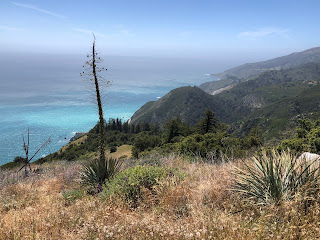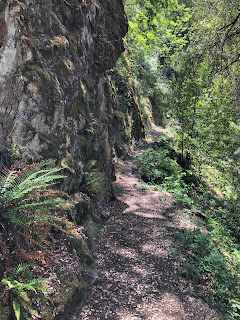Or James Baldwin, in an 1968 interview with Esquire, saying, "What causes the eruptions, the riots, the revolts—whatever you want to call them—is the despair of being in a static position, absolutely static, of watching your father, your brother, your uncle, or your cousin—no matter how old the black cat is or how young—who has no future. And when the summer comes, both fathers and sons are in the streets—they can't stay in the houses. I was born in those houses and I know. And it's not their fault."
I will just slip in a link to Trevor Noah talking about George Floyd, the Minneapolis Protests, Ahmaud Arbery, and Amy Cooper here. Because it's powerful and ties in to all this. And Trevor is a very wise man.
I'm not here to write about that, though, or even to have an opinion. What I want to do is simply to begin compiling a list of resources I can turn to to understand better the awful racism of this country. I started today listening to a relatively recent podcast, Seeing White, season 2 of Scene on Radio (a project of the Racial Equity Institute) with John Biewen and scholar, journalist, and activist Dr. Chenjerai Kumanyika:
Just what is going on with white people? Police shootings of unarmed African Americans. Acts of domestic terrorism by white supremacists. The renewed embrace of raw, undisguised white-identity politics. Unending racial inequity in schools, housing, criminal justice, and hiring. Some of this feels new, but in truth it’s an old story. Why? Where did the notion of “whiteness” come from? What does it mean? What is whiteness for?Of course this is something I should have considered before, and I have, glancingly—for example, through association with a local group called Whites for Racial Equity. One of their regular activities is a book group, launched in June 2016; they have read the following titles:
- Chris Crass, Towards the "Other America": Anti-Racist Resources for White People Taking Action for Black Lives Matter
- Ta-Nehisi Coates, Between the World and Me
- Chimananda Ngozi Adichie, Americanah
- Carol Anderson, White Rage: The Unspoken Truth of Our Racial Divide
- Courtney Parker West, "On 'Woke' White People Advertising Their Shock That Racism Just Won a Presidency"
- Wesley Lowery, They Can't Kill Us All
- Toni Morrison, The Bluest Eye
- James Baldwin, Go Tell It on the Mountain
- Eula Biss, Notes from No Man's Land: American Essays
- Claude M. Steele, Whistling Vivaldi: How Stereotypes Affect Us and What We Can Do
- Angie Thomas, The Hate U Give
- Claudia Rankine, Citizen: An American Lyric
- James Baldwin, "Letter from a Region in My Mind"
- Michael Eric Dyson, Tears We Cannot Stop: A Sermon to White America
- Howard Thurman, Jesus and the Disinherited
- Paul Kivel, Uprooting Racism: How White People Can Work for Racial Justice
- Roxanne Dunbar-Ortiz and Dina Gilio-Whitacker, "All the Real Indians Died Off": And 20 Other Myths about Native Americans
- Patrisse Khan-Cullors and asha bandele, When They Call You a Terrorist
- Poor People's Campaign, "The Souls of Poor Folk, a Preliminary Report"
- Toni Morrison, The Origin of Others
- Jordan Flaherty, No More Heroes: Grassroots Challenges to the Savior Mentality
- Ijeoma Oluo, So You Want to Talk about Race?
- Robin DiAngelo, White Fragility: Why It's So Hard for White People to Talk about Racism
- Ta-Nehisi Coates, We Were Eight Years in Power
- America Ferrera, American Like Me: Reflections on Life between Cultures
- Reni Eddo-Lodge, Why I Am No Longer Talking to White People about Race
- Nana Kwame Adjei-Brenyah, Friday Black: Stories
- Michelle Obama, Becoming
- Michael Eric Dyson, What the Truth Sounds Like
- Willy Wilkinson, Born on the Edge of Race and Gender: A Voice for Cultural Competency
- Jennifer L. Eberhardt, Biased: Uncovering the Hidden Prejudice That Shapes What We See, Think, and Do
- Akiba Solomon and Kenrya Rankin, How We Fight White Supremacy: A Field Guide to Black Resistance
- Colson Whitehead, Nickel Boys
- Thi Bui, The Best We Could Do
- Carole Anderson, One Person, No Vote
- Eric Gansworth, Give Me Some Truth
- Zora Neale Huston, Their Eyes Were Watching God
- Ibram X. Kendi, How to Be an Anti-Racist
- Ibram X. Kendi, Stamped from the Beginning: The Definitive History of Racist Ideas in America
- Rion Amilcar Scott, The World Doesn't Require You: Stories
- Nell Irvin Painter, The History of White People
- Gwen Westerman and Bruce White, Mni Sota Makoce: The Land of the Dakota
- Mary Wingerd, North Country: The Making of Minnesota
- Shannon Sullivan, Revealing Whiteness: The Unconscious Habits of Racial Privilege
- Shannon Sullivan, Good White People: The Problem with Middle-Class White Anti-Racism
- Dorothy Roberts, Fatal Invention: How Science, Politics, and Big Business Re-Create Race in the Twenty-First Century
- Elliott Jaspin, Buried in the Bitter Waters: The Hidden History of Racial Cleansings in America
- Myra Greene's website My White Friends
- Bryan Anderson, Just Mercy: A Story of Justice and Redemption
- Ashraf H. A. Rushdy, American Lynching
- Jessmyn Ward, The Fire This Time
- James Baldwin, The Fire Next Time
- Cherrie Moraga and Gloria Anzaldua, eds., This Bridge Called My Back: Writings by Radical Women of Color
- Eduarto Bonilla-Silva, Racism without Racists: Color-blind Racism and the Persistence of Racial Inequality in America
- Layla F. Saad, Me and White Supremacy: Combat Racism, Change the World, and Become a Good Ancestor
- Isabel Wilkerson, The Warmth of Other Suns: The Epic Story of America's Great Migration
- Kevin Kruse, White Flight: Atlanta and the Making of Modern Conservatism
- George Lipsitz, The Possessive Investment in Whiteness: How White People Profit from Identity Politics
- Audre Lorde, Sister Outsider: Essays and Speeches
- Michelle Alexander, The New Jim Crow: Mass Incarceration in the Age of Colorblindness
- Ira Katznelson, When Affirmative Action Was White: An Untold History of Racial Inequality in Twentieth-Century America
- Ian Haney López, Dog Whistle Politics: How Coded Racial Appeals Have Reinvented Racism and Wrecked the Middle Class
- Terrance MacMullan, Habits of Whiteness: A Pragmatist Reconstruction
- Melissa V. Harris-Perry, Sister Citizen: Shame, Stereotypes, and Black Women in America
- Brittney Cooper, Eloquent Rage: A Black Feminist Discovers Her Superpower
- Jennifer Harvey, Raising White Kids: Bringing Up Children in a Racially Unjust America
[Update, June 7: A friend today posted a link to a long-form BBC program(me) on race in America, The Documentary.]
[Update, June 8: Another list of various kinds of resources, including resources for photographers, the 1619 podcast on slavery, diverse books for children, and much more.]
[Update, June 12: Another list of resources for all ages, curated by Dr. Nicole A. Cooke (aka NicoletheLibrarian) at the University of South Carolina.]
[Update, June 19: Five Ways to Show Up for Racial Justice Today.]
So many resources. I have read a very few of these books, and I own a few others. I would like to educate myself better on this tangled, gnarly, perplexing, confounded issue that is part of what makes America the complicated country that it is.
Here is John Biewen giving a TED Talk about "seeing white"—which of course gets both positive and negative comments, probably simply because . . . he's white. Damned if you do, damned if you don't. But there we are.
P.S. What partly got me here today with this topic—this heartache, really—was an ultimately hostile exchange between a couple of friends of mine on FB, one an immigrant to this country long ago, her people the victims of genocide in the last century, and trying to be an "ally" in the racial struggles we are facing; the other also an immigrant and black and proudly militant and outspoken. The latter wanted the former, basically, to admit that she is a "Karen"—a person of white privilege, but in a vapid, unaware, entitled way. Which the former definitely is not. Harsh words were typed. The former ended up unfriending the latter—which caused more words. In a way, it seems petty—"unfriending"; suffering because of flame wars on social media. But it's really deadly serious. I admire both these women, and I learn from both of them—from their anger, from their pride, from what little I know of their own personal experience in life generally, from their vulnerability and honesty and passion. I follow them in part to keep learning from them. I may not always "agree" with what they say (generally, it's not really my place to agree, or to disagree); but I value their perspectives, and their fire. I consider them teachers, in a way. So yes: these lists are partly the result of their altercation, which ended on one side in confusion and the unfriending. Which is too bad.
~~~~~~~~~~~~~~~~~~~~~~
Monterey County's cases rose by 32 since yesterday, to 507; hospitalizations by 2, to 59; and deaths remain steady at 10.
Stay healthy. Be kind. Try to put yourself in other people's shoes.

















































